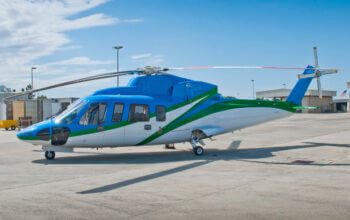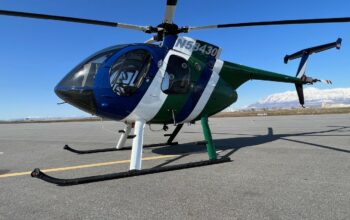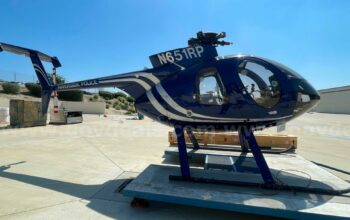The U.S. Navy is rafting up to the Army’s Future Vertical Lift (FVL) game, launching an official search for possible successors to the MH-60R/S Seahawk and MQ-8 Fire Scout unmanned helicopter.
Navy officials plan to conduct an analysis of alternatives (AoA) “to identify cost-effective alternatives to fill capability gaps in the MH-60R/S and MQ-8C as they begin to reach their end of service in the 2030s,” according to a notice published Jan. 28 on the U.S. government’s contracting website.

Planned capabilities for an FVL Maritime Strike (MS) were approved in November 2019 when the service established a requirement for a vertical lift capability to replace the Navy’s existing fleet of MH-60R/S and MQ-8B/C systems. FVL-MS is expected to enter service in the mid-2030s, about the same time the Army’s Future Long Range Assault Aircraft (FLRAA) comes online to begin replacing the UH-60 Back Hawk.
“The MH-60 Seahawk helicopters and the MQ-8 Fire Scout unmanned air vehicles are the pillars of the Naval Helicopter Concept of Operations for the 21st century,” the Navy’s AoA notice said. “The warfighting capability provided, whether deployed as carrier air wing squadrons embarked on aircraft carriers under the leadership of carrier air wing commanders or as expeditionary squadrons embarked on . . . surface combatants and logistics vessels, is broad and unparalleled in naval warfare.”
FVL is an Army-led program aimed at replacing the land service’s legacy aircraft with a family of speedier, more technologically advanced rotorcraft. Aside from FLRAA, the program includes the Future Attack Reconnaissance Aircraft (FARA) that will fill the gap left by retirement of the OH-58D Kiowa Warrior, and the Future Tactical Unmanned Aerial System (FTUAS) that will supplant the RQ-7 Shadow drone.
Bell’s V-280 Valor advanced tiltrotor and the Sikorsky-Boeing Defiant X are competing to become FLRAA. A marinized version of either aircraft could fit the Navy’s bill, as it is looking to replace the marinized version of the Black Hawk.

Bell has toyed with designing a version of the V-280 optimized for use aboard ships, going so far as to produce models of the tiltrotor that sport a three-barrel rotary nose cannon and internally stored Hellfire missile launchers.
When Sikorsky and Boeing unveiled the SB>1 Defiant, the compound coaxial helicopter was pitched as “maritime capable. In a video released in 2015, the companies showed animations of the aircraft with blades folded, riding the hangar elevator and taking off from the deck of a Navy assault ship.

The Navy and Marine Corps have long considered hitching development of a new maritime utility aircraft to the Army’s FVL program. Maritime Strike initially was termed “Capability Set 2” on a scale of FVL aircraft that eventually will replace everything from attack aircraft to the CH-47 heavy-lift helicopter.
FLRAA originally was Capability Set 3 until it became a funded program of record and assumed its acronym. FARA was derived from what was originally FVL Capability Set 1.
“CapSet 2” was envisioned as a medium-lift rotorcraft with a speed between 170 and 270 knots, and a combat radius of between 300 and 437 nautical miles (555 to 810 kilometers) carrying eight to 10 passengers. It would have an internal payload of up to 5,000 pounds (2,260 kilograms) and an external payload of up to 8,000 lb. (3,600 kg). All of that is subject to change as the Navy moves forward with its AoA and development of formal requirements for FVL-MS.
MH-60 Seahawks fly from Navy ships, to perform a range of missions including anti-submarine and anti-surface ship warfare, surveillance, communications relay, combat search-and-rescue and logistics support. The MQ-8C is an unmanned version of the Bell 407 with a range of 150 nautical miles capable of autonomous takeoff and landing from Navy ships that works in concert with manned rotorcraft.
Both aircraft need to be replaced in order to address increasingly sophisticated adversaries and the expected retirement of both aircraft. Potential FVL Maritime Strike aircraft will be evaluated on the ability to conduct more than a dozen missions specified in no particular order in the Navy’s AoA announcement.
They are: intelligence, surveillance, reconnaissance, and targeting (ISR&T); surface warfare (SUW); anti-submarine warfare (ASW); mine counter measures (MCM); air warfare (AW); electronic warfare (EW); search-and-rescue (SAR); command and control; special operations forces support; embark aviation and air capable ships; logistics; patient movement; and signature control, which likely refers to a reduced acoustic and heat signature for the aircraft.
Industry responses to the AoA are due in 75 days on April 13.









Bell has Alfred shown how a naval V-280 would fold up to fit on an DDG, saying it will fit in the same hangar as a folded UH-1Y. How the heck, though would a Defiant fold up (including lowering the mast) to do the same? I haven’t heard anyone address this